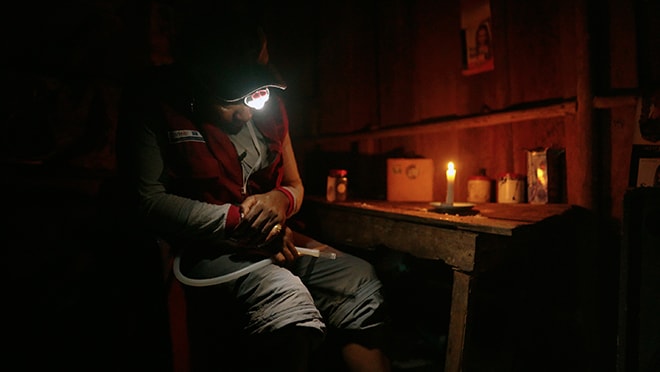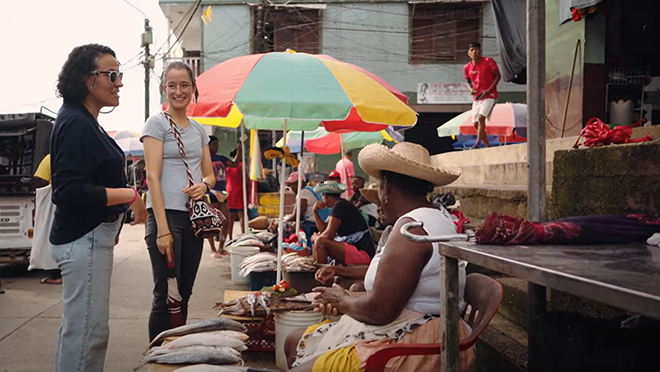At a glance
Researchers have long noticed a gap in the information on the effectiveness of the standard vector control tools used to prevent malaria in Latin America and the Caribbean. This World Mosquito Day, CDC wanted to highlight its partnership with the Government of Colombia to study two of these tools—insecticide-treated nets and indoor residual spraying. This uncovered surprising insights into local mosquito behavior which is paving the way for additional research into other malaria prevention tools. Photo on right of local staff member Esther Montaño by Juan David Falconi.

Mosquito Research in Colombia Provides Valuable Insight into Effectiveness of Malaria Control Tools
The region of the Americas has experienced notable declines in malaria in recent decades. However, persistent hot spots of transmission remain. Researchers from the CDC and the Government of Colombia partnered to determine the impact of two standard malaria vector control tools—insecticide-treated nets (ITNs) and indoor residual spraying (IRS). Given the diversity of mosquito populations and their varying behaviors worldwide, it is crucial to assess whether investments in these tools are effectively reducing mosquito populations in high malaria risk settings. The Cauca region in Colombia was an ideal location for the study due to the need for more data, relatively high levels of malaria transmission, abundance of Anopheles mosquitoes (the types of mosquitoes that transmit malaria), and the support from the Instituto Nacional de Salud and the Secretaria de Salud del Cauca.

Researchers have long noticed a gap in the information on the effectiveness of the standard vector control tools used to prevent malaria in Latin America and the Caribbean (LAC). With funding from USAID, DPDM's Entomology Branch saw an opportunity to learn more about how ITNs and IRS were effective under the living conditions specific to the area. Rebecca Levine PhD, a senior scientist in the branch, designed the study by determining which tools to test and how to test them. CDC's global experience with similar studies and the ability to garner support from ministries of health and local organizations was crucial to launching the project. Additionally, the project needed assistance with logistics, including purchasing supplies, hiring and training local staff, and navigating regional challenges, like keeping equipment safe from rust and fungus due to weather conditions. The development of strong, local partnerships was key to the project's success.

Throughout the project, CDC and partners generated an unprecedented volume of entomological information which will serve as an invaluable resource to guiding malaria control efforts in similar settings. CDC expected to primarily collect Anopheles albimanus, yet 85% of the mosquitoes captured were Anopheles neivai. This species was not commonly thought to be a principal malaria vector. The researchers learned that An. neivai primarily bites people earlier, at dusk, and outside, in contrast to most other Anopheles mosquitoes that feed later in the evening or at night and typically inside homes. As the study's project manager in Colombia, Manuela Herrera Varela PhD, shares, "Due to the abundance of An. neivai, malaria will persist in the region until we have more effective tools that target their behavior."

Armed with this new information, CDC now knows that the classic mosquito control tools—ITNs and IRS—will miss key human-mosquito exposure windows in the LAC region as they primarily target inside, night feeding mosquitoes. However, Dr Levine shares the importance of the research, “This was a landmark study on malaria vectors and vector control in the Americas. Due to what we’ve learned, and the strong partnerships formed, we’re now prepping for a field trial of spatial repellants in Colombia later this year. Spatial repellants are a new type of mosquito control tool that we hope will be able to fill the gaps that we saw with early and outdoor biting so that we can generate evidence around the best methods to control and eventually eliminate malaria in the LAC region.” The new trial will again be conducted together with Colombia’s Ministry of Health, Colombia’s National Institute of Health, and the Health Secretariat of the Colombian Department of Cauca.
The United States Agency for International Development’s (USAID) Latin America and Caribbean Regional Malaria Program (LAC-RMP) provided funding for the project.
